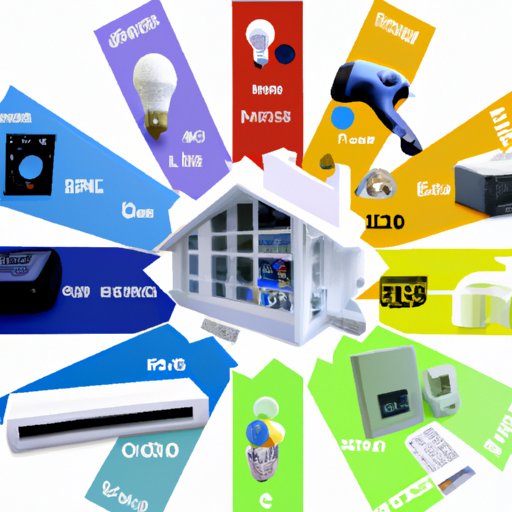Introduction
Understanding energy consumption is key to reducing your household’s environmental impact and cutting costs. Knowing what uses the most energy in your home can help you identify areas where you can make changes to save money and use resources more efficiently.
Energy consumption is defined as the amount of energy used by a particular device or appliance over a given period of time. This includes electricity, natural gas, and other forms of energy. The average American household consumes about 11,000 kilowatt-hours (kWh) of electricity per year, according to the U.S. Energy Information Administration (EIA). That equates to an average monthly electric bill of around $110.
Analyzing Utility Bills to Identify High Energy Usage
The first step to understanding what uses the most energy in your home is to analyze your utility bills. By reviewing your current bill, you can get an idea of where your energy is going and identify areas for improvement.
Start by understanding the different charge components on your bill. Many utility companies break down charges into categories like base rate, fuel adjustment, and taxes. You should also be aware of any additional fees that may be included, such as late payment charges or reconnection fees.
Once you understand the different charges, you can calculate your average daily usage. Divide your total electric bill by the number of days in the billing period to get your daily energy usage. This will give you an idea of how much energy you are using each day and can help you identify areas where you can reduce consumption.

Understanding Electrical Appliances that Use the Most Energy
The next step is to understand which electrical appliances are using the most energy. Common household appliances, such as refrigerators, clothes washers and dryers, dishwashers, and air conditioners, all consume large amounts of electricity. Other electronic devices, such as computers, televisions, and gaming consoles, also use significant amounts of energy.
By understanding how much energy each appliance is consuming, you can identify areas for improvement. Consider replacing older, less efficient appliances with newer models that use less energy. You can also look into energy saving settings, such as setting your refrigerator to a higher temperature and unplugging electronics when not in use.
Exploring Home Automation Solutions to Reduce Energy Consumption
Home automation solutions can also be used to reduce energy consumption. Smart technology allows you to control lights, thermostats, and other appliances remotely with a smartphone or tablet. This makes it easier to manage energy use and save money on utility bills.
There are many benefits to using home automation solutions. For example, you can set schedules for lights and appliances to turn on and off automatically, so you don’t have to worry about forgetting to turn them off. You can also monitor energy use in real-time and adjust settings accordingly.
Examples of automated solutions include smart thermostats, energy monitoring systems, and lighting controls. With these systems, you can set temperature preferences, receive alerts when energy use spikes, and dim or turn off lights when they’re not needed.
Examining Lighting and Heating/Cooling Systems to Improve Efficiency
Lighting and heating/cooling systems are two of the biggest energy consumers in a home. Evaluating existing systems and implementing upgrades can help you reduce energy costs and improve efficiency.
When it comes to lighting, consider switching to LED bulbs, which use 75% less energy than traditional incandescent bulbs. You can also install motion sensors and timers to reduce unnecessary lighting. For heating and cooling, look into programmable thermostats, which allow you to set temperature preferences and create schedules.

Evaluating Insulation and Home Sealing to Cut Energy Costs
Insulation and home sealing are two other important steps to take to reduce energy costs. Assessing existing insulation and sealing doors and windows can help keep warm air inside during the winter and cool air inside during the summer.
When evaluating insulation, check for gaps or cracks in walls and ceilings, and consider adding more insulation if necessary. When it comes to home sealing, look for gaps around windows, doors, and other openings. Caulking and weatherstripping can be used to seal these areas and prevent air leakage.

Investigating Renewable Energy Sources for Your Home
Finally, exploring renewable energy sources is another way to reduce energy costs and reduce your environmental impact. Solar energy and wind energy are two of the most popular renewable energy sources for homes.
When it comes to solar energy, there are several options to consider. Photovoltaic panels can be installed on roofs to generate electricity, while solar water heaters can be used to heat water. Wind turbines are another option for generating electricity. These systems can be installed in open outdoor spaces, such as backyards or fields.
Conclusion
Understanding what uses the most energy in your home is essential for reducing energy consumption and saving money on utility bills. By analyzing your utility bills, understanding electrical appliances, exploring home automation solutions, examining lighting and heating/cooling systems, evaluating insulation and home sealing, and investigating renewable energy sources, you can make informed decisions about how to reduce energy costs and become more energy efficient.
Take the time to review your energy usage and identify areas for improvement. With the right strategies in place, you can make a positive impact on both the environment and your wallet.


